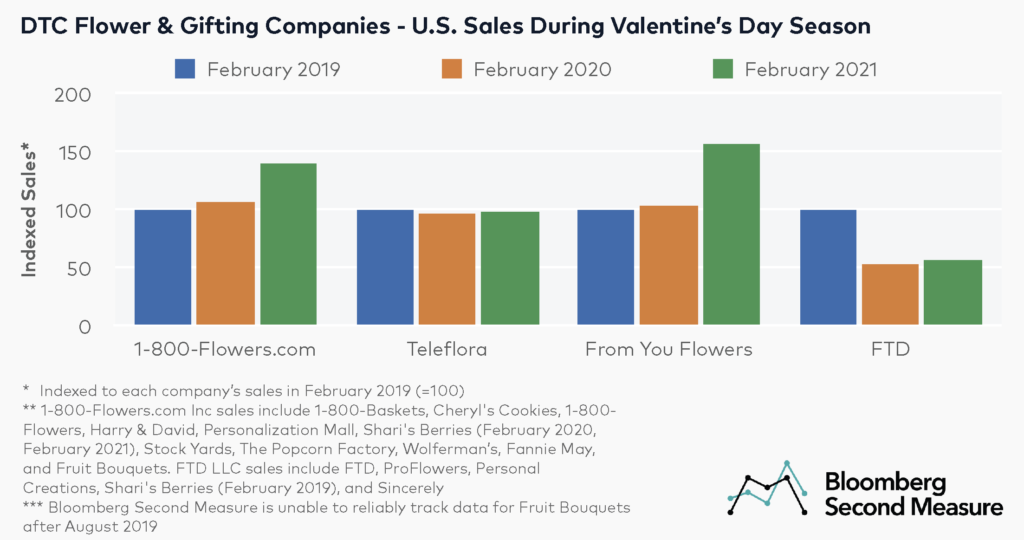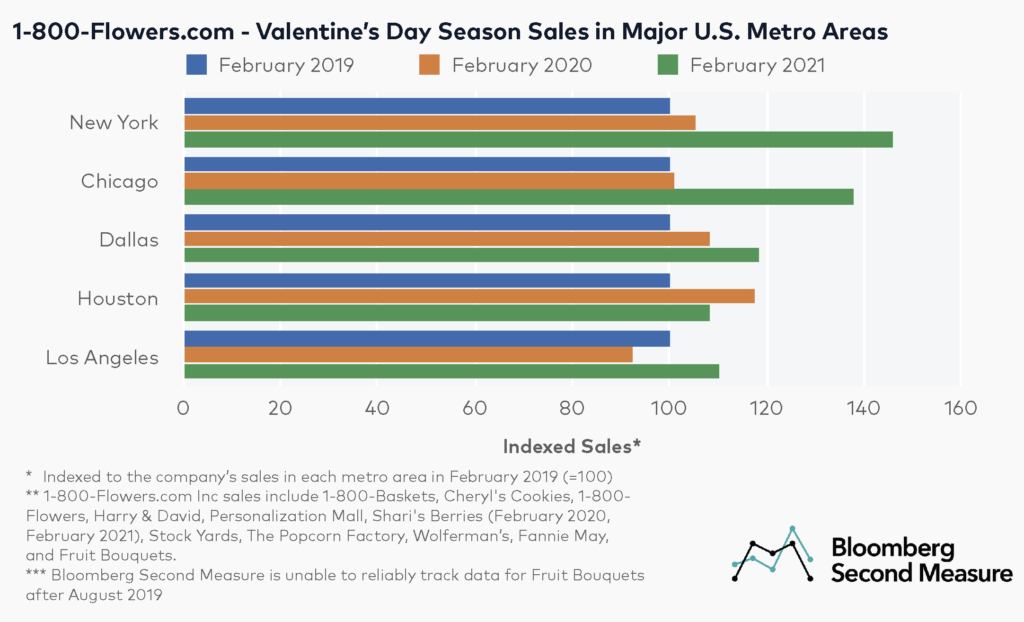NOTE: Bloomberg Second Measure launched a new and exclusive transaction dataset in July 2022. Our data continues to be broadly representative of U.S. consumers. As a result of this panel change, however, we recommend using only the latest posts in assessing metrics, and do not support referring to historical blog posts to infer period-over-period comparisons.
The COVID-19 pandemic brought disruption to the flower industry—from plummeting demand, forcing nurseries globally to destroy millions of flowers early in the pandemic, to the supply chain issues resulting in the global flower shortage more recently. Despite these issues, transaction data shows that sales among DTC flower upstarts jumped during the pandemic, particularly during holidays such as Mother’s Day and Valentine’s Day.
Mixed sales results for flower and gifting companies during the Valentine’s Day season in 2021
While fears of the supply chain disruptions are far from over, a similar trend can be observed among more established DTC flower and gifting companies, such as 1-800-Flowers.com (NASDAQ: FLWS) and From You Flowers. Meanwhile, others such as Teleflora and FTD are yet to see their sales return to their pre-pandemic levels.

Looking at February sales from 2019 through 2021, From You Flowers recorded the biggest year-over-year growth in February 2021, among the companies in our analysis. The company saw its sales up 50 percent compared to February 2020 and up 56 percent compared to February 2019.
1-800-Flowers.com Inc. (which, apart from its namesake brand, includes Cheryl’s Cookies, 1-800-Baskets, Personalization Mall, Stock Yards, The Popcorn Factory, Wolferman’s, Fannie May, Fruit Bouquets, and Shari’s Berries acquired from FTD in 2019) also recorded significant growth in February 2021, with sales up 30 percent compared to February 2020 and up 39 percent compared to the same month in 2019.
Teleflora saw its U.S. sales grow 2 percent year-over-year in February 2021, but decline 2 percent compared to February 2019.
Meanwhile, FTD observed 5 percent growth year-over-year in February 2021. However, the company’s sales were down 43 percent compared to the same month in 2019. The company filed for bankruptcy in June 2019, and apart from Shari’s Berries, sold off Personal Creations, its gadget personalization venture, in August 2019.
1-800-Flowers.com saw its sales blossom in the New York, Chicago, and Los Angeles metro areas
Zooming in on 1-800-Flowers.com, the company with the highest U.S. sales among this selection of competitors, the New York and Chicago metro areas recorded the biggest year-over-year sales increases among the five most populous metro areas during the Valentine’s Day season in 2021. February 2021 sales in the New York and Chicago metro areas grew 39 percent and 37 percent year-over-year, respectively. The Los Angeles metro area also recorded a significant increase in sales in February 2021, with sales up 19 percent year-over-year. Sales in the Dallas metro area were up 9 percent year-over-year.

Meanwhile, 1-800-Flowers.com sales in the Houston metro area decreased 8 percent in February 2021. However, compared to the same month in 2019, the company’s Houston metro area sales were up 8 percent.
1-800-Flowers.com leaders are reportedly betting on strong sales during the 2022 Valentine’s Day season by ramping up its workforce and forecasting capabilities. Companies within the flower industry might also get a further sales boost this year, thanks to DoorDash, which recently announced same-day flower delivery services, and UberEats, which has been offering a similar service via its partnership with FTD since July 2021. Whether the global flower shortage puts a dent into sales growth, or DTC flower and gifting companies come out of the 2022 season all roses, remains to be seen.
*Note: Bloomberg Second Measure regularly refreshes its panel and methods in order to provide the highest quality data that is broadly representative of U.S. consumers. As a result, we may restate historical data, including our blog content.
